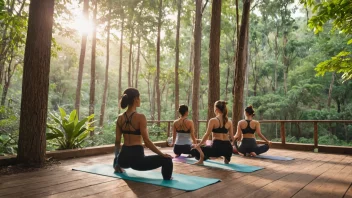In this article, you will discover the vital role that sleep plays in maximizing the benefits of wellness retreats. We will guide you through essential steps to ensure that your sleep quality is optimal during your retreat, allowing you to rejuvenate your body and mind effectively.
Step 1: Choose a Retreat that Prioritizes Sleep
Not all wellness retreats are created equal when it comes to sleep. Here are some factors to consider:
- Accommodation Quality: Look for retreats that offer comfortable sleeping arrangements, including quality mattresses and bedding.
- Quiet Environment: Ensure the retreat is located in a serene area, away from the noise of urban life.
- Sleep-Focused Programs: Some retreats provide workshops or activities centered around sleep health. Research those options!
Step 2: Establish a Pre-Retreat Sleep Routine
Preparing your body for a wellness retreat starts long before you arrive:
- Adjust Your Sleep Schedule: Aim to gradually shift your sleep schedule closer to what it will be during the retreat.
- Limit Screen Time: Reduce exposure to screens at least an hour before bedtime to promote better sleep quality.
- Create a Relaxing Environment: Ensure your home environment is conducive to sleep by keeping it cool, dark, and quiet.
Step 3: Engage in Relaxation Techniques
Incorporating relaxation techniques can enhance your ability to sleep well during your retreat:
- Meditation: Practice mindfulness meditation to calm your mind before sleeping.
- Breathing Exercises: Focused breathing can help relax your body and prepare you for rest.
- Gentle Yoga: Engage in gentle yoga stretches to relieve tension before bedtime.
Step 4: Make the Most of Your Sleep Environment at the Retreat
Once you arrive at your retreat, it’s crucial to optimize your sleep environment:
- Control the Temperature: Adjust the room temperature to a comfortable level, ideally between 60-67°F (15-19°C).
- Limit Light Exposure: Use blackout curtains or eye masks to block light, promoting deeper sleep.
- Minimize Noise: If you are sensitive to noise, consider using earplugs or a white noise machine.
Step 5: Prioritize Sleep During the Retreat
To fully enjoy the benefits of your wellness retreat, prioritize sleep:
- Schedule Downtime: Make sure to incorporate rest time into your daily schedule amidst activities.
- Listen to Your Body: If you feel tired, allow yourself to take a nap or rest instead of pushing through.
- Maintain a Regular Sleep Schedule: Try to go to bed and wake up at the same times each day to regulate your circadian rhythm.
Step 6: Reflect on Your Sleep Experience
After the retreat, take time to reflect on your sleep experience:
- Journaling: Write down your thoughts on how sleep impacted your wellness experience during the retreat.
- Identify Improvements: Consider what strategies worked well and what could be improved for your next retreat.
- Set Future Sleep Goals: Use your reflections to set goals for enhancing your sleep quality in everyday life.
In summary, sleep is a crucial component of any wellness retreat experience. By selecting the right retreat, preparing in advance, engaging in relaxation techniques, optimizing your sleep environment, prioritizing sleep during your stay, and reflecting afterward, you can enhance the benefits of your retreat. Remember, quality sleep fosters a more profound sense of rejuvenation and wellness, allowing you to return to your daily life feeling revitalized and inspired.






